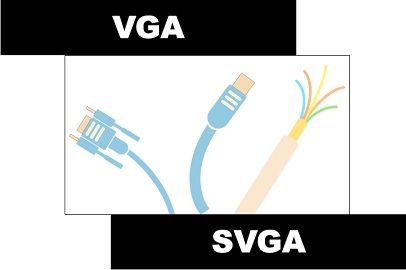 For displaying the content over the various display devices, a various organization has developed the display standards. VGA and SVGA fall in the category of these standards used for channelling the video data to a suitable visual output. VGA (Video Graphics Array) supports smaller resolution videos and images while SVGA is a standard provide large resolution for the displaying the content.
For displaying the content over the various display devices, a various organization has developed the display standards. VGA and SVGA fall in the category of these standards used for channelling the video data to a suitable visual output. VGA (Video Graphics Array) supports smaller resolution videos and images while SVGA is a standard provide large resolution for the displaying the content.
Content: VGA and SVGA
Comparison Chart
| Basis for comparison | VGA | SVGA |
|---|---|---|
| Stands for | Video Graphics Arrays | Super Video Graphics Arrays |
| Maximum resolution/ colours | 640x480/262,144 | 1024x760/262,144 |
| Memory requirement | 256k | 512k-1024k |
Definition of VGA
VGA (Video Graphics Array) standard was first developed by IBM. It offers high resolution with 256 colours at a time and has backward compatibility to the other CGA and EGA modes. VGA enable conducting the video data which can display at maximum 256 colours at a time from a palette of 262,144 colours. It is consist of the 6-Bit Digital to Analog converter to convert analog red, green and blue signals rather than digital RGB signals used by previous display adapters ultimately which facilitates the production of the 256 colours.
DIA (Digital to Analog) converter functions – The 6-bit converter generates 2^6 or 64 possible values. So, for each colour, it produces the 262, 144 colours of a total possible number of combinations for three signals (R, G and B) that are 64x64x64. It consists of 256 colour registers, hence it’s possible to save 256 colours combination at a time. In order to choose one of the 256 colour registers, it will need an 8-bit value/address. This 8-bit address/value is generated in numerous different ways, based on the selected display mode.
Definition of SVGA
SVGA stands for super VGA which is an extension of VGA. The super VGA provides higher resolution with more colours. These boards can function in two modes: 800 x 600 or 1024 x 480. Either of the 16 or 256 colours are supported by both of the modes. However, memory utilization in SVGA is high. To provide high resolution it requires 256 colour supplementary memory which added to the board. The alternate name pf SVGA is enhanced or ultra VGA.
Key Differences Between VGA and SVGA
- The VGA supports 640×480 resolution and 144 , 262 colours. On the other hand, SVGA can provide 1024×760 of resolution and 144 to 262 colours.
- SVGA consumes more than VGA, which can range up to 1024 k while in VGA it can go up to maximum 256 k.
Conclusion
The VGA and SVGA are distinguished on the basis of the resolution where VGA can support at maximum 640×480 resolution while SVGA can provide maximum 1024×760 resolution.
Leave a Reply